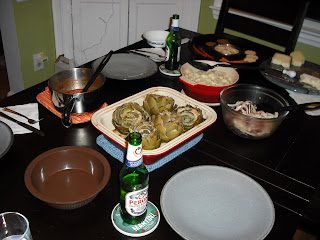
Artichokes are another very Italian food, and since they are back in season I wanted to incorporate them into dinner, too. I had never cooked one before, because they struck me as a high-maintenance vegetable: they are easy to overcook or undercook, their cut surfaces brown almost immediately, they have fuzzy inedible junk in the middle of them, and they are sort of a mess to eat, as you pull off leaves one and a time and drag them between your teeth to get the good stuff out, and you discard the rest. Fussy, no?
However, they are delicious.
One of the purposes of us girls having our dinner club is to try making things we have never cooked before, expanding our culinary repertoires. I enjoy looking for new dishes to challenge me in the kitchen.
The following recipe is not from The Silver Spoon (although that cookbook dedicates eight pages to the lovely carciofi) but instead comes from Giada de Laurentiis of the Food Network.
Baked artichokes with Gorgonzola and herbs
Salt
4 artichokes
3 lemons
10 ounces Gorgonzola cheese, room temperature (MG - I recommend a Gorgonzola dolce rather than one of the stronger varieties)
2 tablespoons cream
2 teaspoons chopped fresh thyme leaves
2 teaspoons chopped fresh parsley leaves, plus 1 tablespoon for garnish
1 clove garlic, minced
1/2 teaspoon freshly ground black pepper
3 tablespoons bread crumbs
1 tablespoon olive oil
Bring a large pot of salted water to a boil over high heat.
Trim the artichokes by cutting off the top 1-inch or so. Cut the stem close to the base of the artichoke, so that the artichoke can sit up straight, and remove some of the bottom leaves. Using kitchen shears, trim the sharp points off any of the remaining outer leaves. (MG - at this point, I recommend having a bowl of acidulated water ready for your artichokes, so you can drop them in as you finish trimming them. They get brown fast!)
Add artichokes to the boiling water. Halve the lemons and squeeze the juice into the boiling water. Toss in the lemons.
Cook the artichokes until tender, about 30 minutes. Drain and let cool.

Boiling the artichokes with the lemons
Meanwhile, in a small bowl stir together the Gorgonzola, cream, thyme, 2 teaspoons parsley, garlic, salt, and pepper. In another small bowl, stir together the bread crumbs and remaining 1 tablespoon of parsley.
Preheat the oven to 400 degrees F.
Remove the center choke of the artichokes using a small spoon. Stuff the cheese mixture into the center of the artichokes.
Place the artichokes into a baking dish. Sprinkle the bread crumb mixture over the top of the artichokes, and drizzle with olive oil. Bake until the artichokes are heated through, the cheese is melted, and the bread crumbs are crisp and golden, about 25 minutes. Transfer to a serving dish and serve.
Makes 4 servings.

The finished products, clockwise from top: Italian white bean hummus;
potato gnocchi; a selection of Italian cheeses; fennel,blood orange, and
walnut salad, baked artichokes with Gorgonzola and herbs, and tomato
sauce (notice the fancy serving dish).

